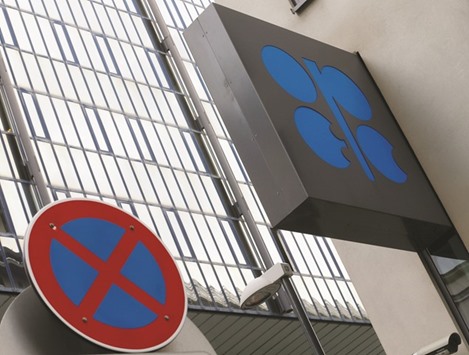Opec meetings aren’t what they used to be.
Far from sending the oil market into gyrations, the run-up to last week’s Opec meeting kept crude pinned near $50 a barrel and sent hedge funds to the sidelines.
Speculators cut their total long and short positions on West Texas Intermediate crude to the lowest since January 2015 and one measure of market volatility fell to a 10-month low before the Organisation of Petroleum Exporting Countries’ June 2 summit. Ministers emerged from the gathering voicing unity and continuing a policy of no production limits. US data released the same day showed oil supplies are dropping, a sign that the supply glut that sent prices plummeting this year is finally dissipating.
“It’s very clear that Opec is less relevant than US production data,” said Rob Thummel, a managing director and portfolio manager at Tortoise Capital Advisors, who helps oversee $14.1bn. “We’re going to trade near $50, plus or minus five bucks, for quite a while,” though higher prices are inevitable, he said in a phone interview.
Prices rallied from a 12-year low earlier this year to reach $50 a barrel as consumers burned through the oversupply. Opec has rejected a production freeze, in part because Iran has said it will continue to boost output after the removal of international sanctions in January. The group estimated it pumped 32.4mn bpd in April. That supply has been balanced by disruptions in Canada, Libya, Nigeria and Venezuela.
WTI rose by 1% to $49.10 a barrel on New York Mercantile Exchange during the CFTC report week. The US benchmark advanced 1.3% to $49.25 at 1.03 pm London time yesterday. Implied volatility on near-term options fell May 27 to the lowest since July.
Money managers reduced their short positions on WTI, or wagers that prices will fall, to 53,377 futures and options during the CFTC’s report week, the lowest level since May 2015. Long positions, or bets that prices will rise, declined 2.9% to 294,105 contracts, the lowest since March.
Speculators raised bullish bets on Brent crude by 2,809 contracts to 383,925 lots in the week ended May 31, according to data from ICE Futures Europe.
Stockpiles in the US fell 1.37mn barrels for the week ended May 27, according to Energy Information Administration data released June 2. Nationwide production declined to 8.74mn bpd, the lowest level since September 2014. Still, the number of active US oil rigs rose by nine to 325 last week, the largest gain of the year, according to Baker Hughes Inc.
“There’s been a lot of big news and little movement,” said Rob Haworth, senior investment strategist in Seattle at US Bank Wealth Management, which oversees $128bn in assets. “Slightly higher prices could bring back US shale producers.”
In other markets, speculators remained bullish on US ultra low sulphur diesel as net-long contracts rose by 16% to the highest level since July 2014. Net longs on Nymex gasoline declined by 24% to 16,128 contracts, with bullish bets falling to the lowest level since October 2013.
“There was long liquidation in the week spanning the Memorial Day holiday, which is the traditional start of the driving season” in the US, Tim Evans, an energy analyst at Citi Futures Perspective in New York, said in a phone interview. Speculators “are not looking for gasoline price strength this summer,” he said.

The logo of the Organisation of the Petroleum Exporting Countries is pictured behind a traffic sign at its headquarters in Vienna, Austria on May 30. Far from sending the oil market into gyrations, the run-up to last week’s Opec meeting kept crude pinned near $50 a barrel and sent hedge funds to the sidelines.
